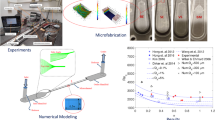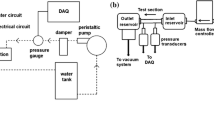Abstract
The first part of this study is focused on the numerical modelling and experimental investigation of transonic flow through a 2D model of the male rotor-housing gap in a dry screw compressor. Numerical simulations of the clearance flow are performed with the help of the in-house compressible Navier-Stokes solver. Experimental measurements based on the Schlieren method in Toepler configuration are carried out. The objective of the second part of the study is to derive the analytical solution of gas microflow development in a gap between two parallel plates. The microflow is assumed to be laminar, incompressible and the velocity slip boundary conditions are considered at the walls. The constant velocity profile is prescribed at the inlet. For the mathematical description of the problem, the Oseen equation is used. The analytical results are compared with the numerical ones obtained using the developed incompressible Navier-Stokes solver including the slip flow boundary conditions.
Similar content being viewed by others
References
Barber, R.W., Emerson, D.R.: The influence of Knudsen number on the hydrodynamic development length within parallel plate micro-channels, Advances in Fluid Mechanics IV. Eds.: M. Rahman, R. Verhoeven, C.A. Brebbia, Southampton: WIT Press, pp. 207–216, (2002).
Dongari, N., Agrawal, Ab., Agrawal, Am.: Analytical solution of gaseous slip flow in long microchannels. Int. J. Heat Mass Transfer 50, pp. 3411–3421, (2007).
Ebert, W.A., Sparrow, E.M.: Slip flow in rectangular and annular ducts, J. Basic Eng. 87, pp. 1018–1024, (1965).
Kandlikar, S.G., Garimella, S., Li, D., Colin, S., King, M.R.: Heat transfer and fluid flow in minichannels and microchannels, Elsevier, Amsterdam, (2006).
Karniadakis, G., Beskok, A., Aluru, N.: Microflows and Nanoflows: Fundamentals and Simulation, Springer-Verlag, New York, (2005).
Kim, D., Choi, H.: A second-order time-accurate finite volume method for unsteady incompressible flow on hybrid unstructured grids, J. Computat. Phys. 162(2), pp. 411–428, (2000).
Klášterka, H., Vimmr, J., Hajžman, M.: Contribution to the gas flow and heat transfer modelling in microchannels, Applied and Computational Mechanics 3(1), pp. 63–74, (2009).
Liou, M.-S., Steffen, C.J.: A new flux splitting scheme, J. Computat. Phys. 107, pp. 23–39, (1993).
Morini, G.L., Spiga, M.: Slip flow in rectangular microtubes, Microscale Therm. Eng. 2(4), pp. 273–282, (1998).
Vimmr, J.: Modelling of complex clearance flow in screw-type machines, Mathematics and Computers in Simulation 76(1–3), pp. 229–236, (2007).
Author information
Authors and Affiliations
Corresponding author
Rights and permissions
About this article
Cite this article
Vimmr, J., Klášterka, H., Hajžman, M. et al. Mathematical modelling and experimental investigation of gas flow in minichannels and microchannels. J. Therm. Sci. 19, 289–294 (2010). https://doi.org/10.1007/s11630-010-0385-x
Received:
Published:
Issue Date:
DOI: https://doi.org/10.1007/s11630-010-0385-x




